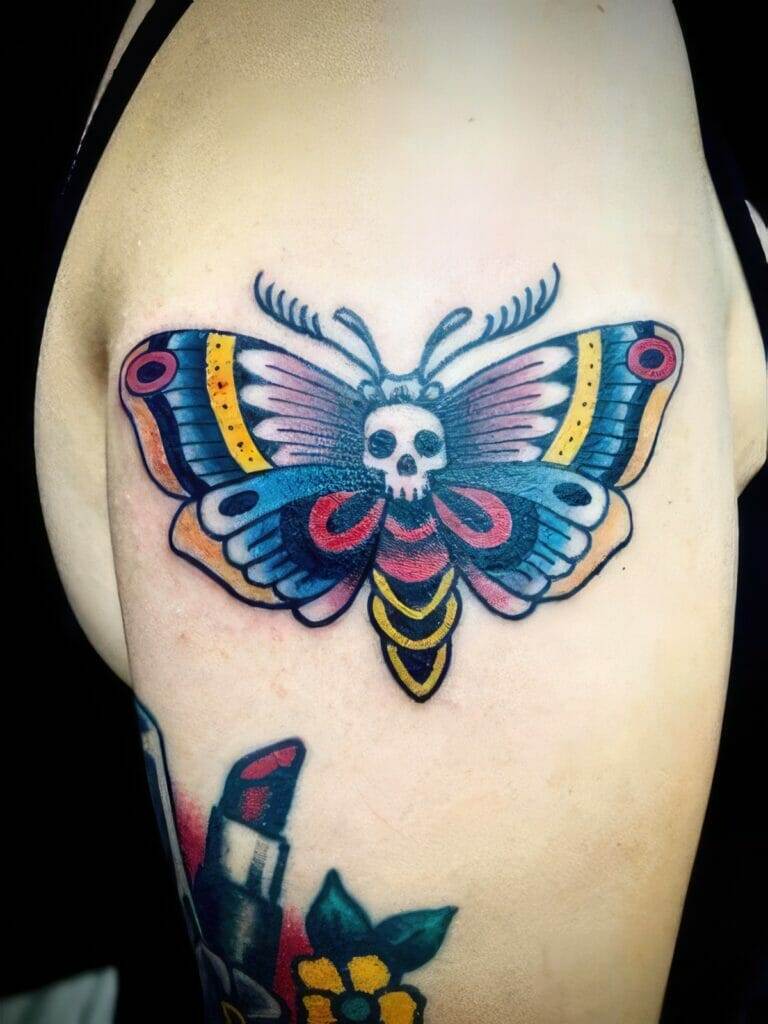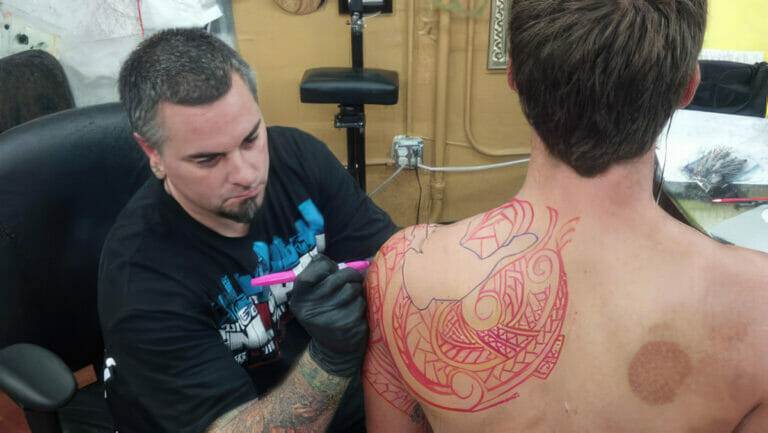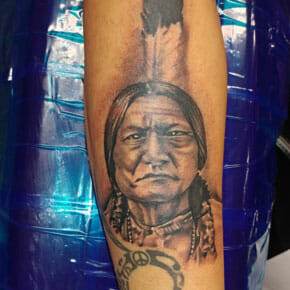
Japanese tattoos, known as irezumi, have a rich history and cultural significance that dates back thousands of years. These intricate and vibrant designs have become iconic symbols of Japanese culture and are admired by people all over the world. From ancient times to modern day, Japanese tattoos have evolved and adapted, but their importance and beauty remain constant. In this article, we will explore the history of Japanese tattoos, their significance in Japanese culture and society, the traditional techniques and tools used in their creation, the meaning behind traditional motifs and symbols, the evolution of Japanese tattoo designs, the role of Japanese tattoo artists in preserving traditional techniques, the global popularity of Japanese tattoos, the controversy surrounding them, and the future of Japanese tattoos.
The History of Japanese Tattoos: From Ancient Times to Modern Day
Tattoos have been a part of Japanese culture for centuries, with early origins dating back to the Jomon period (10,000 BCE – 300 BCE). These early tattoos were simple designs made by rubbing soot into small incisions on the skin. They were believed to have protective and spiritual significance. However, it was during the Kofun period (300 CE – 600 CE) that tattoos began to take on a more decorative role. Chinese culture had a significant influence on Japan during this time, and it was from China that Japan adopted the practice of tattooing as a form of punishment for criminals.
The popularity of tattoos in Japan fluctuated over the centuries. During the Heian period (794 CE – 1185 CE), tattoos were associated with nobility and were often used to enhance beauty. However, during the Edo period (1603 CE – 1868 CE), tattoos became stigmatized and were associated with criminals and outcasts. This negative perception was largely due to the government’s efforts to control and suppress the lower classes.
In modern times, there has been a resurgence of interest in Japanese tattoos. The ban on tattooing was lifted in 1948, and since then, tattoos have become more accepted and mainstream in Japanese society. Today, many people in Japan and around the world choose to get Japanese tattoos as a way to express their individuality and appreciation for Japanese culture.
The Significance of Irezumi in Japanese Culture and Society
Tattoos have played a significant role in Japanese folklore and mythology. In Japanese folklore, it is believed that tattoos have the power to ward off evil spirits and protect the wearer from harm. This belief is rooted in the idea that the intricate designs of tattoos can act as a barrier between the physical and spiritual worlds.
Tattoos also have a strong connection to the yakuza, the Japanese mafia. In the past, many yakuza members would get elaborate full-body tattoos as a sign of their loyalty and commitment to the organization. These tattoos, known as bodysuits or “irezumi,” often depicted traditional motifs such as dragons, koi fish, and cherry blossoms. However, in recent years, the yakuza has been cracking down on members with visible tattoos in an effort to improve their public image.
In modern Japanese society, attitudes towards tattoos have been changing. While there is still some stigma associated with tattoos, especially in more conservative areas, many young people in Japan are embracing tattoos as a form of self-expression. Tattoo artists are gaining recognition for their skill and artistry, and there are even tattoo conventions and exhibitions held throughout the country.
Traditional Japanese Tattoo Techniques and Tools
Traditional Japanese tattooing techniques are highly specialized and require years of training and practice to master. One of the most distinctive features of traditional Japanese tattooing is the use of bamboo and metal needles. Bamboo needles are used for outlining and shading, while metal needles are used for filling in color. The use of bamboo needles allows for more control and precision, resulting in fine lines and intricate details.
Hand-poking techniques are also an important part of traditional Japanese tattooing. Unlike modern tattoo machines, which use electric needles to rapidly puncture the skin, hand-poking involves manually inserting the needle into the skin. This technique allows the artist to have more control over the depth and angle of the needle, resulting in a more precise and detailed tattoo.
Stencils are another essential tool in traditional Japanese tattooing. These stencils, known as horimono, are used to transfer the design onto the skin. The artist will first create a detailed drawing of the design, which is then transferred onto a special stencil paper. The stencil is then applied to the skin and used as a guide for the tattooing process.
The Meaning Behind Traditional Japanese Tattoo Motifs and Symbols
Traditional Japanese tattoos are known for their rich symbolism and meaning. Each motif and symbol has its own significance and can represent various qualities and virtues. Some of the most common motifs found in Japanese tattoos include dragons, koi fish, cherry blossoms, peonies, tigers, and geisha.
Dragons are a popular motif in Japanese tattoos and are often associated with strength, wisdom, and protection. In Japanese mythology, dragons are revered as powerful creatures that can control the elements and bring good fortune.
Koi fish are another popular motif in Japanese tattoos and are often associated with perseverance and determination. In Japanese culture, koi fish are seen as symbols of strength and resilience because of their ability to swim upstream against strong currents.
Cherry blossoms symbolize beauty, transience, and the fleeting nature of life. These delicate flowers bloom for only a short period each year, making them a powerful reminder to cherish every moment.
Peonies represent wealth, prosperity, and good fortune. They are often depicted in full bloom to symbolize abundance and success.
Tigers are symbols of strength, courage, and protection. In Japanese folklore, tigers are believed to ward off evil spirits and bring good luck.
Geisha tattoos are often chosen by those who admire the grace, beauty, and elegance of these traditional Japanese entertainers. Geisha tattoos can represent femininity, artistry, and the pursuit of perfection.
The placement and size of a tattoo also hold significance in Japanese tattooing. For example, a full-body tattoo, known as a bodysuit or “irezumi,” is seen as a sign of dedication and commitment. Tattoos on the back are believed to protect the wearer from harm, while tattoos on the arms and legs are seen as a display of strength and power.
The Evolution of Japanese Tattoo Designs: From Classic to Contemporary

While traditional Japanese tattoo designs have a timeless beauty, they have also evolved over time to incorporate new styles and motifs. One of the biggest influences on Japanese tattooing in recent years has been Western tattoo styles. Western-style tattoos, with their bold lines and vibrant colors, have become increasingly popular in Japan and have influenced the way Japanese tattoo artists approach their craft.
In addition to Western influences, there has also been an emergence of new motifs and designs in Japanese tattooing. Some artists are incorporating elements of pop culture, such as anime and manga characters, into their designs. Others are experimenting with abstract and geometric patterns to create unique and innovative tattoos.
Despite these new influences, many Japanese tattoo artists strive to maintain a balance between traditional and modern styles. They often blend traditional motifs with contemporary techniques to create tattoos that are both timeless and unique.
The Role of Japanese Tattoo Artists in Preserving Traditional Techniques
Japanese tattoo artists play a crucial role in preserving the traditional techniques and tools used in Japanese tattooing. Many artists undergo years of apprenticeship under a master tattooist before they can practice on their own. This apprenticeship system ensures that the knowledge and skills passed down from generation to generation are preserved and respected.
In addition to preserving traditional techniques, Japanese tattoo artists also educate the public about Japanese tattoo culture. They often participate in exhibitions and workshops to showcase their work and share their knowledge with others. Some artists even write books and create documentaries to document the history and significance of Japanese tattoos.
The Global Popularity of Japanese Tattoos: A Cultural Phenomenon
Japanese tattoos have gained immense popularity around the world, especially in Western countries. This global fascination with Japanese tattoos can be attributed to several factors.
One of the main reasons for the popularity of Japanese tattoos is the influence of Japanese pop culture. Anime, manga, and video games have become increasingly popular in Western countries, and many people are drawn to the unique art styles and storytelling techniques found in these mediums. As a result, they are also drawn to the intricate and vibrant designs of Japanese tattoos.
Social media has also played a significant role in the popularity of Japanese tattoos. Platforms like Instagram have allowed tattoo artists to showcase their work to a global audience, making it easier for people to discover and appreciate Japanese tattoo artistry.
The Controversy Surrounding Japanese Tattoos: Taboo or Art Form?
Despite their growing popularity, Japanese tattoos still face some controversy, particularly in Japan. In traditional Japanese society, tattoos are often associated with criminality and are seen as a sign of rebellion. Many public establishments, such as hot springs, public baths, and gyms, still have strict no-tattoo policies.
There is also an ongoing debate over whether tattoos should be considered an art form. Some argue that tattoos are a form of self-expression and should be protected as a legitimate art form. Others believe that tattoos are a form of body modification that goes against traditional cultural norms.
Japanese tattoo artists and enthusiasts face legal and social challenges due to these negative perceptions. Some artists have been denied entry into public establishments or faced discrimination in the workplace because of their tattoos. However, there are also efforts being made to change these attitudes and promote a more accepting and inclusive society.
The Future of Japanese Tattoos: Innovation and Adaptation
The future of Japanese tattoos is filled with possibilities for innovation and adaptation. As technology continues to advance, new tools and techniques may be developed that will revolutionize the tattooing process. For example, there are already tattoo machines that use air pressure instead of electricity to create tattoos, which could potentially be used in Japanese tattooing.
It is also important for Japanese tattoo artists to adapt to changing attitudes and trends. As tattoos become more accepted in Japanese society, artists may need to find new ways to differentiate themselves and stand out in a crowded market. This could involve experimenting with new styles, motifs, and techniques to create tattoos that are both traditional and contemporary.
Japanese tattoo artists will continue to play a crucial role in shaping the future of the industry. Their dedication to preserving traditional techniques and educating the public about Japanese tattoo culture will ensure that the art form continues to thrive and evolve.
Getting a Japanese Tattoo: Tips and Advice for First-Timers
If you are considering getting a Japanese tattoo, there are a few things you should keep in mind. First, it is important to research tattoo artists and studios before making a decision. Look for artists who specialize in Japanese tattoos and have a portfolio of their work available for you to view. This will give you an idea of their style and skill level.
It is also important to understand the cultural significance of Japanese tattoos before getting one. Educate yourself about the meaning behind different motifs and symbols so that you can choose a design that resonates with you personally.
Finally, be prepared for the tattooing process and take proper care of your tattoo afterwards. Getting a tattoo can be a painful experience, so make sure you are mentally and physically prepared. After the tattoo is done, follow the aftercare instructions provided by your artist to ensure proper healing and prevent infection.
Japanese tattoos have a long and storied history that is deeply intertwined with Japanese culture and society. From their early origins to their modern-day resurgence, Japanese tattoos have evolved and adapted while maintaining their significance and beauty. The traditional techniques and tools used in Japanese tattooing, as well as the meaning behind traditional motifs and symbols, make these tattoos truly unique.
The global popularity of Japanese tattoos is a testament to their enduring appeal. Despite the controversy surrounding them, Japanese tattoos continue to captivate people around the world with their intricate designs and rich symbolism. As the industry evolves and adapts to changing attitudes and trends, Japanese tattoo artists will continue to play a vital role in preserving traditional techniques and shaping the future of the industry.
Whether you are a tattoo enthusiast or simply appreciate the artistry of Japanese tattoos, it is clear that these tattoos hold a special place in global culture. Their beauty, symbolism, and cultural significance make them a timeless art form that will continue to inspire and captivate for generations to come.
If you’re interested in Japanese tattoos and want to learn more about the artists behind these intricate designs, check out this article on Redemption Ink’s website. The article titled “Tattoo Artist Highlight: J-Trip” introduces you to the talented J-Trip, a tattoo artist known for his expertise in Japanese tattooing. Discover his unique style and the inspiration behind his work by clicking here.






